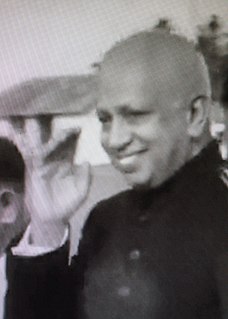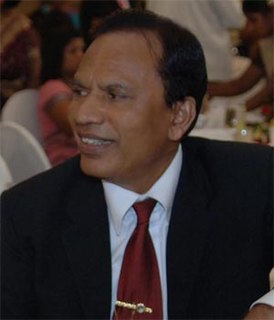
Sri Lankabhimanya Ranasinghe Premadasa was the third President of Sri Lanka from 2 January 1989 to 1 May 1993. Before that, he served as the prime minister in the government headed by J. R. Jayewardene from 6 February 1978 to 1 January 1989. He was awarded Sri Lanka's highest award to a civilian Sri Lankabhimanya in 1986 by President Junius Richard Jayewardene, the first to receive in Sri Lankan history.

The United National Party, often abbreviated as UNP, is a centre-right political party in Sri Lanka. The UNP has served as the country's ruling party, or as part of its governing coalition, for 38 of the country's 74 years of independence. This includes the periods 1947–1956, 1965–1970, 1977–1994, 2001–2004, 2015–2019 and 2022–Present. The party also controlled the executive presidency from its formation in 1978 until 1994 and the current President Ranil Wickremasinghe is the leader of the party.

Solomon West Ridgeway Dias Bandaranaike, often referred to by his initials as S. W. R. D. or S. W. R. D. Bandaranaike and known by the Sri Lankan people as "The Silver Bell of Asia", was the fourth Prime Minister of the Dominion of Ceylon, serving from 1956 until his assassination in 1959. The founder of the left-wing and Sinhalese nationalist Sri Lanka Freedom Party, his tenure saw the country's first left-wing reforms.

Deshamanya Robin Bradman Weerakoon, CCS is a Sri Lankan civil servant. As a senior bureaucrat of the Sri Lankan government, he served nine Sri Lankan heads of state in a career spanning half a century.

Sir Oliver Ernest Goonetilleke was a Sri Lankan statesman. Having served as an important figure in the gradual independence of Ceylon from Britain, he became the third Governor-General of Ceylon (1954–1962). He was the first Ceylonese individual to hold the vice-regal post.
The Sri Lanka Administrative Service (SLAS) is the key administrative service of the Government of Sri Lanka, with civil servants working for both in the Central Government as well as in the provincial councils. It was formed as the Ceylon Administrative Service (CAS) in 1963 as the successor to the Ceylon Civil Service which was abolished on May 1, 1963. It is the senior of the public services.

The Speaker of the Parliament of the Democratic Socialist Republic of Sri Lanka is the presiding officer of the chamber. The current Speaker of the Parliament is Mahinda Yapa Abeywardena, in office since 20 August 2020. The Speaker fulfills a number of important functions in relation to the operation of the House, which is based upon the British Westminster Parliamentary system.

The Presidential Secretariat is the office of the President of Sri Lanka. It provides the administrative and institutional framework for the exercise of the duties, responsibilities and powers vested in the President by the Constitution. The Presidential Secretariat is located in the Old Parliament Building in Colombo.

Sanath Rathnayake Weerakoon, is a Sri Lankan former government agent. He served as the government agent for the District of Colombo (1990–1999), Sri Lanka, and is considered one of the most distinguished and respected officers in the Sri Lankan Administrative Service. He served as the government agent of Colombo for 10 years under two different governments and is a feat that has not yet been broken. Weerakoon was also the youngest appointed government agent, to the District of Puttalam in 1978. The government agent is the administrative had of public services in the district. The post is one of the oldest in the civil service as it had been established by the British during the colonial era. Weerakoon is the current add. private secretary to the president of Sri Lanka.
The Cabinet Office is a department of the Government of Sri Lanka responsible for supporting the Cabinet of Sri Lanka. The department was formed in 1947 when the first cabinet of the Dominion of Ceylon was formed, headed by The Rt Hon D.S. Senanayake, first Prime Minister of Ceylon. Currently it is based at the Republic Building, Colombo were the cabinet meets weekly. The head of the Cabinet Office is the Cabinet Secretary.

Ratnayake Wasala Mudiyanselage Abeyratne Ratnayaka was a Sri Lankan politician. He was the first Cabinet Minister of Food, Co-operatives; Minister of Home Affairs in independent Ceylon and the last President of the Senate of Ceylon.
The Ministry of Finance, Economic Stabilization and National Policies is a cabinet ministry of the Government of Sri Lanka responsible for developing and executing the government's public finance policy, economic policy and long term fiscal planning. The Treasury is housed at the General Treasury Building in Fort.

Ananda Wahihana Palliya Guruge, known as Ananda W.P. Guruge, was a Sri Lankan diplomat, Buddhist scholar and writer. Guruge was the former Ambassador Extraordinary and Plenipotentiary of Sri Lanka to UNESCO, France, and United States during the period from 1985 to 1994. Guruge was adjunct professor of Religious Studies at Cal State Fullerton and was the dean of academic affairs at University of the West.
The 1966 alleged Ceylonese coup d'état attempt was an alleged military coup planned in Sri Lanka (Ceylon). The commander of the army and several military personnel were arrested. They were later acquitted of a plot to overthrow the legally elected government.

The Prime Minister of the Democratic Socialist Republic of Sri Lanka is the head and most senior member of parliament in the cabinet of ministers. It is the second-most powerful position in Sri Lanka's executive branch behind the president, who is the constitutional chief executive. The Cabinet is collectively held accountable to parliament for their policies and actions.
Grama Niladhari is a Sri Lankan public official appointed by the central government to carry out administrative duties in a grama niladhari division, which is a sub-unit of a divisional secretariat. They come under the Grama Niladhari Division under the Home Affairs Division of the Ministry of Home Affairs. There are 14,022 grama niladhari divisions under 331 divisional secretary’s division in the island.
Pararajasingam "Park" Nadesan, was a Ceylonese civil servant. He was the Secretary to the Prime Minister of Ceylon.









